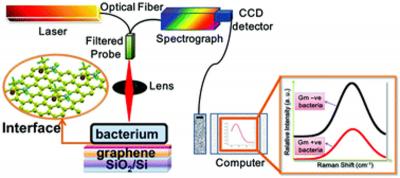Researchers from Myongji University, Sungkyunkwan University, Gachon University and Korea Institute of Science and Technology in South Korea, along with U.S-based Villanova University, have developed a new device concept for bacterial sensing by Raman spectroscopy and voltage-gated monolayer graphene.

Synthesis of the monolayer graphene was done by chemical vapor deposition (CVD) on a Cu foil, which was eventually channelized onto a SiO2 /Si substrate. Modification of Raman spectra is examined in the study in order to develop ultra-sensitive biosensing techniques for the detection, identification, differentiation and classification of bacteria associated with infectious diseases.
Density functional theory was employed to elucidate the graphene/bacteria interfacial electronic interactions. The experimental data supports the notion that identification, differentiation, detection, and classification of bacteria can be achieved by voltage gated monolayer graphene via direct Raman spectroscopy measurements.

